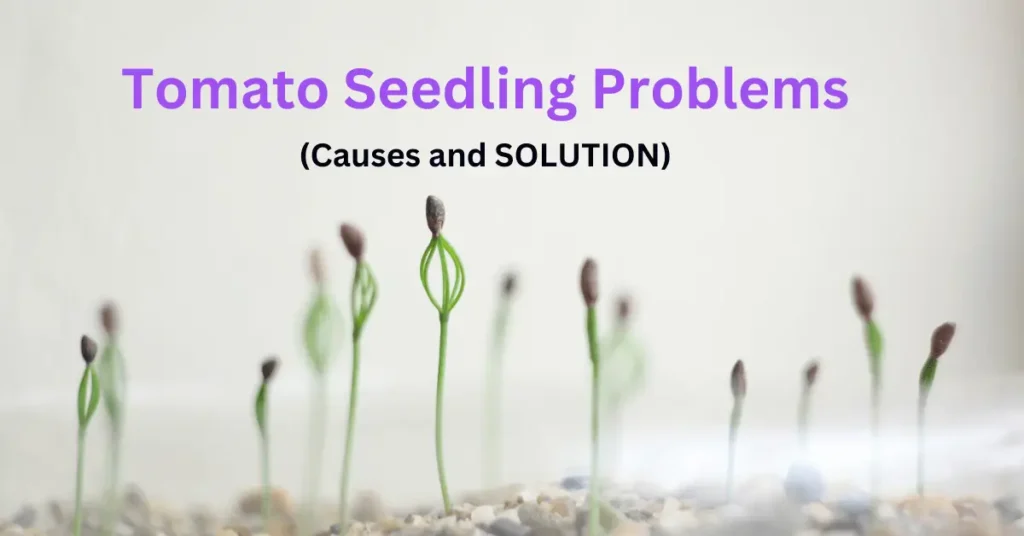Tomato seedling problems? Growing tomato seedlings can be a rewarding experience, but it’s not uncommon for growers to encounter a few problems along the way. Here are common tomato seedling problems, their causes, and how to solve them.
Tomato Seedlings Problems (Causes)
- Damping off: Damping off is a fungal disease that affects seedlings and can cause them to wilt and collapse.
- Leggy seedlings: Seedlings that are too tall and spindly with weak stems are known as leggy seedlings. So leggy tomato seedlings are spindly and tall tomato seedlings.
- Stunted growth: This is where your tomato plants do not grow tall to its normal expected height.
- Yellowing leaves: Yellowing leaves of your tomatoes can be a sign of a nutrient deficiency, overwatering tomato plants, or underwatering your tomato plants.
- Blossom end rot: Blossom end rot is a common problem in tomatoes and is caused by a lack of calcium in the soil. It appears as a brown, leathery patch on the bottom of the tomato fruit.
- Sunscald: Sunscald is a common problem in tomatoes and is caused by prolonged exposure to direct sunlight.
- Insect damage: Insects such as aphids, whiteflies, spider mites, and tomato hornworms can damage tomato seedlings by feeding on the leaves and stems.
- Poor germination: Poor germination can be caused by a number of factors, including old or damaged seeds, poor soil quality, or incorrect planting depth.
- Crowding: Crowding is where a lot of seedings are together in a small space. Crowding can cause seedlings to compete for light, water, and nutrients, leading to weak, spindly plants.
- Transplant shock: Transplant shock is a common problem when seedlings are moved from a seed tray or pot to a larger container or the garden. It is caused by a disruption in the plant’s root system and can result in wilting and slowed growth.
- Yellowing seedlings: Seedlings have yellow or pale leaves. This can be caused by nutrient deficiencies, excessive watering, or pests.
- Wilting or drooping: Seedlings are wilting or drooping. This could be caused by over- or under-watering, pests, or disease.
- Purpling seedlings: Seedlings have purple pigmentation on the leaves and stems. This is often caused by a lack of sunlight.
- Browning seedlings: The leaves or stems of the seedlings are turning brown. This could be a sign of disease or pests.
- Slow growth: Seedlings are not growing as quickly as desired. This could be due to insufficient light, poor soil quality, or pests.
- White leaves problem: The leaves of the seedlings are turning white. This could be a sign of nutrient deficiencies or pests.
- Seedlings wilted or dead: Seedlings are wilted or dead. This could be caused by over-watering tomato seedlings or under-watering your tomato seedlings, pests, or disease.

Tomato Seedling Problems (Solution)
- Damping off: To prevent damping off, use sterile seed-starting mix, water seedlings from the bottom, and provide good ventilation. Avoid overcrowding seedlings and keep the soil temperature between 70-80°F. If you do see symptoms of damping off, remove the infected plants and dispose of them.
- Leggy seedlings: To prevent leggy tomato seedlings, provide plenty of bright, indirect light and keep seedlings at least 6 inches away from grow lights or windows. You can also use a grow light with a red spectrum to encourage shorter, stockier plants.
- Stunted growth: To prevent stunted growth, use a high-quality seed-starting mix and fertilize regularly with a balanced fertilizer. Keep an eye out for pests and treat accordingly.
- Yellowing leaves: To prevent yellowing leaves, make sure to fertilize seedlings regularly and check the soil moisture level to ensure that seedlings are getting the right amount of water.
- Blossom end rot: To prevent blossom end rot, make sure to add calcium to the soil and water plants consistently to prevent fluctuations in soil moisture.
- Sunscald: To prevent sunscald, make sure to provide plants with enough shade or cover them with a cloth or mulch to protect them from direct sunlight.
- Insect damage: To prevent insect damage, keep an eye out for signs of infestation and use organic pest control methods or pesticides if necessary.
- Poor germination: To prevent poor germination, use fresh, high-quality seeds and plant them at the recommended depth in a sterile seed-starting mix.
- Crowding: To prevent crowding, thin out seedlings by snipping off the weaker ones at the base when they are small.
- Transplant shock: To prevent transplant shock, handle seedlings carefully when transplanting and water them well after transplanting to help them establish a strong root system.
- Yellowing seedlings: Adjust watering habits, fertilize seedlings, or treat for pests.
- Wilting or drooping: Adjust watering habits, treat for pests, or apply a fungicide.
- Purpling seedlings: Provide more light or move seedlings to a sunnier location.
- Browning seedlings: Apply a fungicide or insecticide, or treat for pests.
- Slow growth: Provide more light, improve soil quality, or treat for pests.
- White leaves problem: Fertilize seedlings or treat for pests.
- Seedlings wilted or dead: Adjust watering habits, treat for pests, or apply a fungicide.
Tomato seedlings can be prone to a variety of problems, including damping off, aphids, spider mites, leaf spots, root rot, etc.
It is important to be vigilant in identifying and addressing these problems to ensure the health and success of your tomato plants.
By following proper watering of your tomato plants, planting, and care practices, you can help prevent many common tomato seedling problems from affecting your tomato seedlings.
If you do encounter any issues, it is a good idea to consult with a gardening expert or seek advice from a reputable gardening website or resource.
With the right knowledge and care, you can successfully grow healthy, productive tomato plants.

